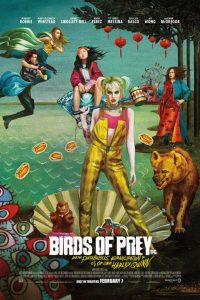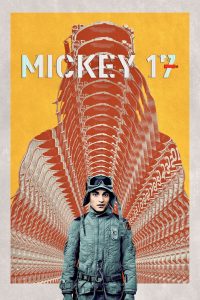Two Thousand Translations: A Speech Odyssey: A Review of Arrival
 by Gary Westfahl
by Gary Westfahl
Denis Villeneuve’s Arrival is a film that will be properly praised as an unusually intelligent and sensitive science fiction film, derived from an unusually intelligent and sensitive science fiction story, Ted Chiang’s “Story of Your Life” (1998). In many respects, it is faithful to Chiang’s novella: linguist Dr. Louise Banks, enlisted to translate the enigmatic spoken and written languages of visiting aliens, finds that as she masters the languages and their subtleties, she develops the aliens’ ability to see one’s entire past and future life, and she has recurring “memories” of the short, tragic life of her future daughter. However, as invariably happens when Hollywood adapts even the finest science fiction literature available, certain aspects of the source material are, well, lost in translation.
Certain alterations in Chiang’s novella are innocuous enough. In contrast to having Banks and physicist Gary Donnelly interact with the aliens solely by means of a television screen, Villeneuve and screenwriter Eric Heisserer naturally prefer the visual drama of having them board an alien spacecraft to stand next to the aliens, separated by a transparent wall. While Chiang’s “heptapods” were said to look like “a barrel suspended at the intersection of seven limbs … radially symmetric,” the filmmakers provide them with a physiology recalling an elongated octopus, a resemblance heightened by the decision to have them form circular images of their writing by shooting black ink out of their tentacles (providing more striking visuals than the “flat circular screen mounted on a small pedestal” they employed in the story). And at their base, the tentacles look like elephant trunks, likening them to another familiar animal. Chiang’s story is as much about physics as linguistics, as the heptapods interpret all actions in “variational” rather than “causal” terms in a manner corresponding to their “nonlinear” view of time; but while the film sporadically endeavors to speak knowledgeably about linguistics (listing Professor Jessica Coon of McGill University as its “consulting linguist”), all of the story’s physics is ignored, evidently regarded as too abstruse for typical filmgoers. Another difficult subject that the film mostly avoids is the heptapods’ perception of time, as they live their lives fully aware of both their past and future; the film does show Banks developing this power, and includes some relevant language from the story, but clearly does not want to dwell upon this topic, given the troublesome questions about free will that arise (and that Chiang addresses). Still, no one has ever successfully pitched a film by exclaiming, “It’s all about free will versus determinism!,” and it is hard to fault filmmakers for steering clear of such matters.
In larger respects, however, Villeneuve and Heisserer have shaped their story in ways that seem, well, alien to Chiang’s approach. To employ terms frequently applied to Chiang’s remarkable talents, “Story of Your Life” is delicately and meticulously balanced between the story of Banks’s work with the aliens and the story of her daughter’s life, which is the novella’s emotional center. The filmmakers, predictably, chose to marginalize the daughter, now named Hannah (Jadyn Malone, Carmela Nossa Guizzo, Abigail Pniowsky, and Julia Scarlett Dan), and place the aliens at the forefront, symbolized by the fact that, while Chiang’s story never bothers to specify the size of either the aliens or their spaceships, the film makes them both huge, enabling them to dominate every scene in which they appear. To be sure, the film does include occasional snippets of Hannah at various ages, but these lack the depth and conviction of Chiang’s better developed vignettes, which collectively convey a vivid portrait of the sparkling, impetuous girl destined to die at the age of twenty-five in a fatal mountain climbing accident. Indeed, as if determined to make the character as bland as possible, the film instead has her succumb to some unspecified disease, apparently before reaching adulthood.
As for the aliens, they apparently have relatively little impact on the world in Chiang’s story: they sit quietly in their spaceships, converse with humans as best they can for a while, and then depart. It probably never occurred to a thoughtful man like Chiang that anyone on Earth would be troubled or frightened by such behavior. Yet in the film, the arrival of the aliens immediately sparks what the news networks label the “Alien Crisis,” igniting widespread paranoia, panic, and rioting, and providing the film with a patina of panoramic spectacle that is very unlike Chiang’s intimate drama. Further, these developments transform the story into yet another contribution to one of the oldest, and most simple-minded, debates in the history of science fiction film: if aliens come to Earth, should we assume they are friendly and remain calm, or should we assume they are hostile and attack them? The battle lines were drawn long ago in two 1951 films, The Day the Earth Stood Still and The Thing (from Another World): in the first film, the trigger-happy soldiers seeking to kill Klaatu are the villains, while those who befriend him are the heroes; in the second film, the soldiers striving to kill that “intelligent carrot” are the heroes, while the misguided scientist who wants to preserve his life is the villain. Arrival adopts the stance of The Day the Earth Stood Still: we admire Banks (Amy Adams) and Donnelly, renamed Ian (Jeremy Renner), because they are determined to maintain friendly contact with the aliens, and we dislike their military supervisor, Colonel Weber (Forest Whitaker) because he is constantly suspicious of the aliens (in contrast to the story’s more supportive Weber). The film also adds another apparent villain, China’s military leader General Shang (Tzi Ma), who is planning an all-out attack on their spaceships.
In a few strange ways, the filmmakers have even tinkered with Chiang’s story to parallel The Day the Earth Stood Still. Like Klaatu, and more explicitly than in the story, the film’s aliens have come to Earth, in part, to provide humanity with a gift; like Klaatu and Gort, they forge a special bond with one sympathetic Earth woman, as they at one point offer Banks a special invitation to individually visit their spaceship; and like Klaatu, one alien is attacked by soldiers and apparently killed. To be sure, unlike The Day the Earth Stood Still, Arrival could not plausibly suggest any sort of romance between Banks and its aliens, since they look like a cross between an octopus and an elephant, but they are humanized to a limited extent by abandoning the names invented for them in the story, Flapper and Raspberry, to have Donnelly dub them Abbott and Costello (which arguably conveys as well that the films of the 1950s represent the film’s conceptual foundation).
One of the many brilliancies of Stanley Kubrick’s 2001: A Space Odyssey (1968) is that it completely transcends the elementary friend-or-foe debate that permeates other films about aliens, persuasively arguing instead that advanced aliens are likely to be so utterly different from humans as to render the question of whether to befriend them or slaughter them moot. And if you are wondering why I am mentioning so many old science fiction films, Arrival is forcing the issue in this case, since it is yet another science fiction film filled with references to 2001. Chiang’s story suggests that Banks’s new perception of time was an unplanned effect of learning the heptapods’ language; the film indicates that the aliens deliberately want to provide humans with this heightened awareness, so that like the aliens in 2001, they are deliberately trying to alter the course of human evolution. The linkage is reinforced by homages to specific images and scenes: although the alien spaceships are rounded to resemble elongated shells, these black, vertically positioned structures inexorably recall the monoliths; an image of Banks looking up at the spaceship next to a shining sun is similar to one image of the prehistoric monolith; when Banks reaches out to touch the spaceship, she does so in precisely the same way that Heywood R. Floyd touched the lunar monolith; after donning her contamination suit, she hears the sound of her own breathing, just like the 2001 astronauts; when six figures in bulky contamination suits walk down a corridor to meet with the aliens, one has to think about the six figures in bulky spacesuits who walked down a ramp to examine the lunar monolith; and to transport Banks into their spaceship, the aliens send down a miniature monolith.
But it is easy to mimic specific scenes in 2001; it is much more difficult to emulate Kubrick’s amazing courage in refusing to explain the nature and motives of his film’s unseen aliens, and Chiang similarly allows his aliens to largely remain mysterious, as the story concludes with Banks noting, “We never did learn why the heptapods left, any more than we learned what brought them here or why they acted they way they did.” Here, as in other films endeavoring to follow in the footsteps of 2001 ranging from atrocities like Mission to Mars (2000) to respectable failures like Interstellar (2014) (review here) , Villeneuve and Heisserer make the mistake of explaining too much, as we eventually learn precisely why they came to Earth and why they left, and, as was not in the case in “Story of Your Life,” their language translates much too easily into simple English statements (at one point conveyed in helpful subtitles). In this way, a story that sought to emphasize how and why communication can be so difficult has paradoxically engendered a film arguing that, with a little bit of effort, communication can become as easy as pie. (Perhaps I should say “as easy as pi,” since the principal means of communication is drawings of circles.)
Arrival is also in dialogue with earlier science fiction films regarding another recurring issue: if governments did discover evidence of aliens, should they keep that knowledge to themselves or reveal it to the public? In 2001, the core reason for the conflicting instructions that dangerously maddened HAL 9000 was the government’s determination to keep the lunar monolith a secret, and Close Encounters of the Third Kind (1977) is explicitly critical of the United States government’s efforts to conceal the arrival of aliens on Earth. In this case, the number and immense size of the alien spacecraft presumably eliminated the possibility of secrecy, yet the film goes on to suggest that everyone would have been better off if the aliens had remained a secret – primarily because of the baleful influence of the film’s other villains, the media.
From the onset, the film shows that even in the age of the internet, television remains the preferred source for breaking news: as she walks to her classroom, Banks observes students crowding around a television; while the few students in her class all have laptops, one asks her to turn on a television news channel; and throughout the film, important new developments are conveyed by recurring clips of television newscasters. Further underlining the importance of the media is the fact that soldiers have dubbed the room where the aliens are viewed as “the show,” and Hannah is given a class assignment to devise her own television show, which she calls “Mommy and Daddy Talk to Animals,” apparently her distorted recollection of her parents’ alien encounters. Yet with little additional information to convey, the media – especially the right-wing media – drift into speculations that only serve to fuel unrest and violence. Thus, Banks must tell her mother, fearful of the aliens, to stop paying attention to the “idiots on one channel,” clearly the Fox News Channel; a doppelgänger of radio host Rush Limbaugh is shown demanding military actions against the aliens; and the soldiers who decide to attack the aliens are said to have “been watching too much TV.” In widespread coverage of jammed freeways, rioting and looting, the government’s “ban on new gun licenses,” the self-immolation of a religious cult that regarded the aliens as the fulfillment of a prophecy, and the investigator’s child who “asked if monsters are going to kill daddy,” the film illustrates precisely the sort of widespread “culture shock” that 2001’s bureaucrats were so desperate to avoid.
One way to counteract the harmful impact of the media is to vigorously engage in private communication, another of the film’s recurring themes. The aliens have set up a system to avoid appearing on television, preferring intimate conversations with Banks and Donnelly and with humans on the other eleven spaceships; experts at all twelve sites regular consult with each other via Skype; the aliens apparently endeavor to reduce tensions on Earth by means of different private messages to their twelve sets of human contacts; and Banks makes a crucial phone call to a key player’s private cell phone. One result of this is that, like Interstellar, Arrival becomes a film with too much chatter, in contrast to the effectual silences of 2001; it also makes it all the more strange that the film, unlike the story, completely ignores the heptapods’ spoken language to focus only on their writing.
Another problem with the media is that, while at times dutifully attentive to ordinary people, they primarily celebrate and valorize celebrities; and, as she becomes a central figure in a worldwide media event, the film must transform Louise Banks into a celebrity as well – the quiet triumphs described in Chiang’s story are simply not enough. Thus, the film must inform us that she becomes the author of a popular book, The Universal Language: Translating Heptapod; she is observed lecturing on that topic to an audience of rapt listeners; and she is one star attraction at a grand and glamorous party, attended by world leaders, celebrating the New World Order that emerges after the departure of the aliens. One of those leaders effectively identifies Banks as the woman who single-handedly saved the world. It is hard to reconcile all of this with the Banks of Chiang’s story, who cherishes the quotidian life of raising her spirited daughter and never suggests she has become world-famous.
Overall, I know that I did not enjoy Arrival as much as I should have, and find it hard to communicate exactly why that is the case. Certainly, I cannot shake the feeling that everything about the film – the acting, cinematography, special effects – seems serviceable but perfunctory, as if the creative personnel, realizing that they were blessed with excellent source material and an excellent screenplay, never felt any need to work especially hard in order to produce an excellent film. Yet I suspect the main problem is my familiarity with the story that inspired the film, which I might compare to a Bach prelude: brisk, precisely constructed, and appealing because of its grace and charm. Imagine an arranger who seizes upon a Bach prelude and transforms it into a bombastic symphony for full orchestra and chorus; the result might be a magnificent work of art on its own terms, but anyone familiar with the prelude will listen uneasily, sensing that something has gone awry. And when he watches Arrival, even while appreciating the well-deserved boost in income that it brought, I suspect that Ted Chiang feels the same way.








Saw the film before reading the story so not burdened with fore-knowledge. Much better treatment than most speculative fiction films. Unlike you, I found the technical aspects quite well-done. The (mostly) understated acting, the dampened visual style, the lack of overdone CGI all contributed to my enjoyment. And, while to story does run some familiar paths, I found the references reverential. All in all, the best film I have seen this year.
Hmmm, you seemed to have approached the film as a sort of checklist, to see how well it adapts its source story. That’s your right, but you give away major spoilers early on in your review for those of us who haven’t read the story. I saw the film today, before reading this review, so I wasn’t spoiled on the film’s big twist, but you might put in some verbiage at the top of your review warning folks. As for the film itself, I thought it could’ve used a bit more plot to it, not too much, but it has pretty much one central idea and belabors it at points, enough that its imbalanced for the last 10 minutes or so as it tries to show all the pieces going together.